
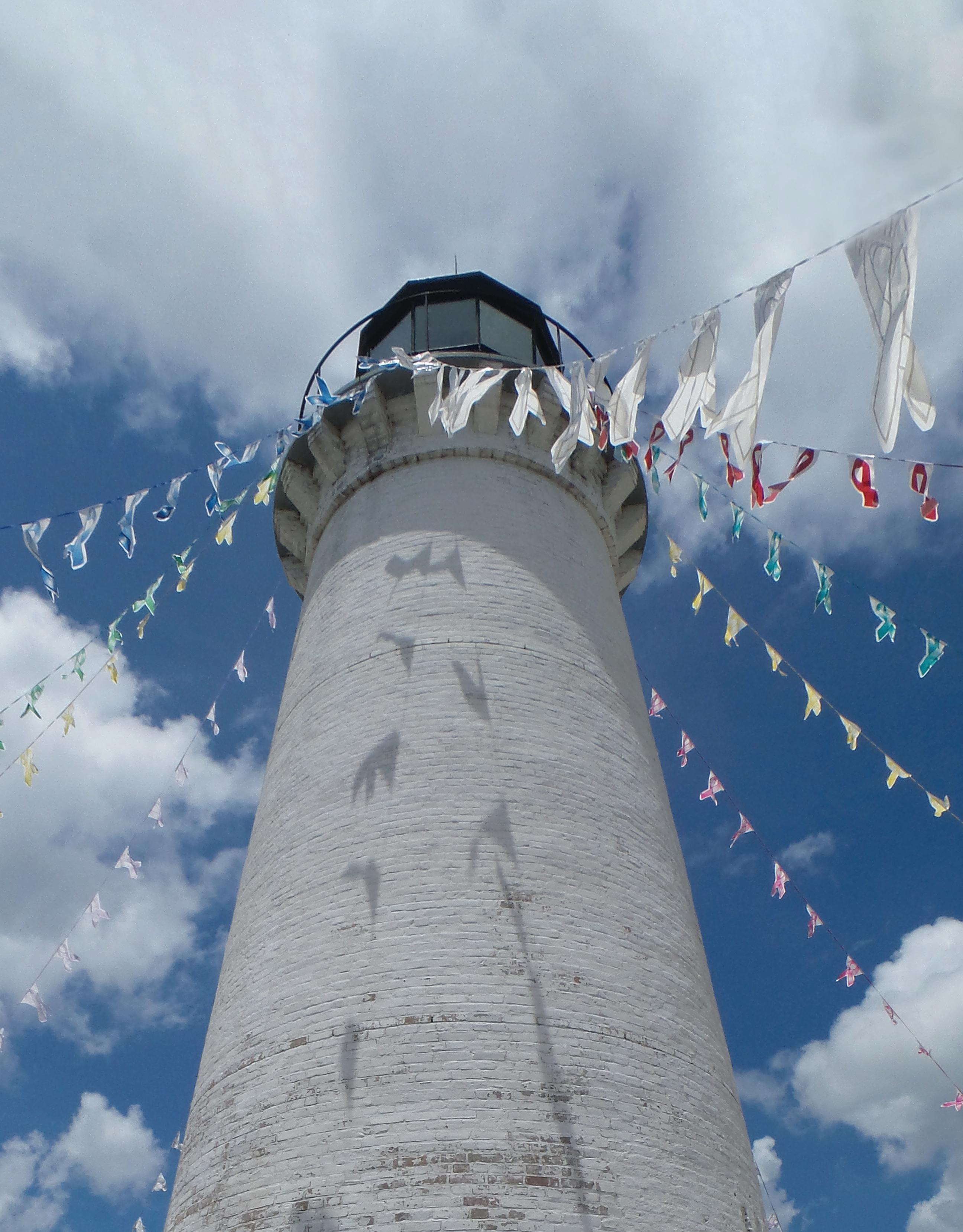
yesterday • today • tomorrow CULTURAL
MISSISSIPPI GULF COAST NATIONAL HERITAGE PUBLICATION | SUMMER 2023
STORY embrace your
Chaucer and the Rolling Stones both used the phrase ‘time waits for no one,’ and I must agree, because it’s already summer! How did that happen?

I’m thrilled to invite you to our summer issue where you will experience a restored lighthouse, the versatility of historic train depots and mural and art walks throughout the Gulf Coast - one of my all-time favorite things to do.

If you’re looking to give back to the community this summer, consider volunteering or joining a citizen science group. PaddletheGulf.org offers Citizen Science Adventures. Whether you are interested in collecting data with scientists on tracking invasive species or tracking marine debris, check out their website. A great way to take advantage of those activities may be opportunities to help at MSU Extension/MS Master Naturalists, their website has a thorough list of opportunities like nurdle patrol, Biloxi Majestic Tree Program, Audubon Coastal Bird Program and the Crosby Arboretum.
Visitors and tourists play a vital role in preserving our history, supporting local businesses and promoting our region as a must-visit destination for the coast’s rich history, abundant natural resources and beautiful waterways. Whatever you decide to do this summer - volunteer, visit some local lighthouses or murals or try some fabulous plein air diningdon’t wait, because remember, ‘time waits for no one.’
MISSISSIPPI DEPARTMENT OF MARINE RESOURCES
Joe Spraggins, Executive Director
Rhonda Price, MS Coast NHA Director
Andrew Barrett, Heritage Coordinator
Jeff Rosenberg, Heritage Coordinator
RoxAnn Rankin Wicker, Communications Coordinator
Joyce Hart, Administrative Assistant

Marie Lewis, Administrative Assistant
THANK YOU!
A very special thank you to our contributors, George Ramseur and Kate Dawson (page 12) and Ray Bellande for his article on Gulf Hills (page 35). We appreciate your willingness to share the historically cultural, naturally flavorful stories of the Mississippi Coast National Heritage Area. Your generosity helps tell our stories.
U.S. SENATORS
Cindy Hyde-Smith
702 Hart Senate Office Building
Washington, DC 20510
Phone: (202) 224-5054
Roger Wicker
555 Dirksen Senate Office Building
Washington, DC 20510
Phone: (202) 224-6253
U.S.
REPRESENTATIVE (DISTRICT 4)
Congressman Mike Ezell 443 Canon HOB
Washington, DC 20515
Phone: (202) 225-5772
Cover Photo, Round Island Lighthouse Ceremony
Rhonda Price MSCNHA Director
welcome FROM OUR DIRECTOR
MISSIONour
ENHANCE, CONSERVE AND PROVIDE CONNECTIVITY to cultural resources of a unique and defined area through identification, interpretation and promotion.
CREATE AUTHENTIC EXPERIENCES and serve as a source of pride. Providing increased awareness and appreciation of their environment, history, culture, traditions and lifestyles.
PROMOTE ECONOMIC SUSTAINABILITY of heritage resources that benefit the entire region and support the long-term enhancement and conservation of those qualities that make the six counties of the MS Coast NHA unique.

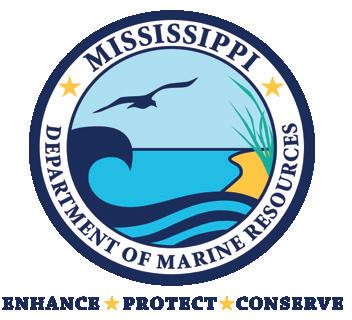
TELLING THE AREA’S NATIONALLY SIGNIFICANT STORY to residents and visitors through activities and partnerships that celebrate the area’s unique history, people, traditions and landscapes.
Your MS Coast NHA is a partnership of communities, businesses, governmental agencies, non-profit organizations and individuals who value the region’s rich cultural and environmental diversity, history, natural beauty and traditions.



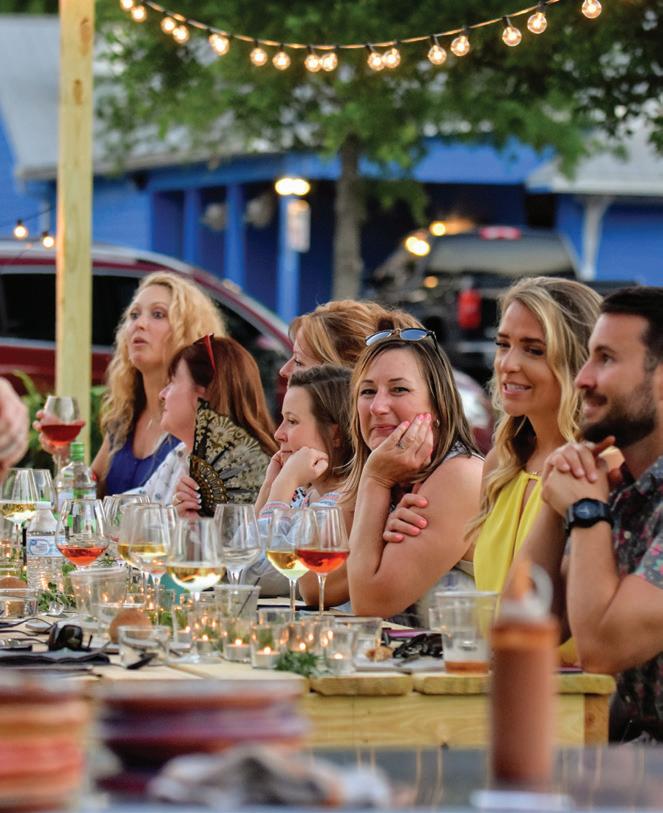




CONTENTS HISTORICAL 2 The Guardian Light: Round Island Lighthouse from tragedy to triumph 6 Covering Our Tracks: From Station to Station: A look at the Coast's Historic Train Depots INNOVATIVE 12 Gettin' Round to Restoration 14 The R/V Conservationist: Historic Lugger Continues Enhancing Oyster Population NATURAL 19 Blueway Spotlight: Grassy Point Trail COMMUNITY 22 Streetscape: Murals Along the Coast 31 Food, Booze & Hiccups Outpost Spotlight LIFE 35 The Course to Gulf Hills FLAVORFUL 38 Edd's Drive-In 39 Hummingbird Cake 14 31 6 36 38 19
HISTORICAL

Historical | 1
The Guardian Light
Round Island
Lighthouse from tragedy to triumph
 Words by Roxann Rankin Wicker
Words by Roxann Rankin Wicker
2 | Embrace Your Cultural Story
Top Left: Round Island, 1984.

Middle: Author, 8th birthday at Round Island, Below: Author, hiding on stairwell at Round Island photos courtesy of Joe Rankin Collection.
One could argue I have had saltwater running through my veins since birth. I was born the day before Thanksgiving in 1976, and by New Year’s Eve, I was strapped into a makeshift car seat on the bow of my Daddy’s old wooden skiff. He set out to Round Island Lighthouse just off the banks of the Mississippi Sound in Pascagoula to capture his baby girl’s maiden voyage to the shore.
Each year for my birthday we would make our tradition ‘run out to Round,’ which lasted until I was eight or nine. Back in those days, Round Island Lighthouse was just off the edge of the shore, she stood abandoned with her beacon dimmed. There was a magnificence about the tower of light to my youthful eyes. Her bold, blackened cupola set against the clear, cloudless skies starkly contrasted with her ombre sand and clay-colored brick and mortar. The doorway was long forgotten, the spiral stairwell damaged, but accessible, the Innkeeper’s quarters destroyed by fire and the lookout bridge, a menacing risk. It was romantic and rugged at the same time. To the tomboy in me, it was an adventure I dreamed of as my celebration of life came full circle. As I aged, my Daddy and his favored buddies would tag along while I played on the beach searching and scouring for any evidence of wayward times in part from scallywags, remnants of old war memorabilia, buried treasure and anything else I could find myself into.
My Daddy was a novice local historian, a photographer and lover of Polaroid lenses, an artist and a lighthouse connoisseur. Not only was this his most admired lighthouse, but it was also the lighthouse for which he was most knowledgeable. In the late 1980s, the lighthouse was still standing on the rock-bedded shoreline – where it stood for over 100 years. However, erosion was taking its toll on the old gal. To my amazement, I learned she was the second lighthouse on the island. The first had not been well constructed for the sand and sea of the Mississippi seasonal changes.
Opposite: Round Island photo courtesy of Pascagoula Public Library Historical
In 1831, Congress appropriated funding for the Gulf Coast region to construct a lighthouse in Pascagoula. This lighthouse would be constructed for a whopping $5,895 (over $200,000 today) and awarded to the highest contract bidder. The original lighthouse was completed in 1833. Unfortunately, coupled with poor construction, erosion, shifting shorelines and hurricane winds, the original lighthouse only survived 20 years of service.


| 3
The most significant historical event may have occurred on Round Island in 1849 – a military standoff between the U.S. Navy and mercenaries planning a forcible release of Cuba from Spain. Narciso Lopez, a former Venezuelan colonel in the Spanish army, and his assembly of several hundred men established a camp on the island to await supplies and orders. President Zachary Taylor ordered arrests and prosecution of those who attempted to violate the U.S. neutrality law, dispatching three U.S. Navy ships outfitted with unarmed enlistees to blockade the island and declare martial law. The standoff ended on September 5, 1849, lasting only a few weeks when U.S. Navy Commander Victor Randolph lifted the blockade due to threats of legal action by the state of Mississippi. Out of supplies, and mosquito-bitten, the would-be mercenaries disbanded and went home.
In 1859, the second brick beacon was constructed and stood as a beloved terminal for boaters and seafarers heading to the island. This new, 50-foot lighthouse was outfitted with a keeper’s quarter and an oil-burning Fresnel lens that could stretch her visible reach to 12 nautical miles. The fourth-order Fresnel lens was removed during the Civil War and later relit after it made its way home from Birmingham for protection. The second lighthouse would stand tall, her lantern gallery posed atop the statuesque guardian on land until her demise at the hands of Hurricane Georges in 1998.



Hurricane Georges’ wake slowly plowed over the 150-year-old lighthouse; my beloved memories toppled into the Mississippi Sound. The lantern gallery corroded in sand bed brine wasting away in the salt water. The only remnant left was the base of the lighthouse with twothirds of the original brick still holding on. The scene was evidence of a story that would carry on, even in the reign of destruction. A lighthouse rebuild was advocated by a group of residents of the community, known as the Round Island Lighthouse Preservation Society, which raised enough funding to have the remains moved and part of the structure reset onto the island until Hurricane Katrina destroyed the temporary structure in 2005.
Following Hurricane Katrina, an undertaking to recover and rebuild the lighthouse began almost immediately. A barge loaded with the base brought up from the muckladen shoreline hauled in as much salvaged material as possible to recreate the lighthouse to its last model. With help from a preservation committee pushing for grant funding, sponsorships and donations, the friend that
4 | Embrace Your Cultural Story
Photos courtesy of Joe Rankin Collection, reprints.
once stood with valor as mariners departed the sound would find a new home as a welcome beacon into the City of Pascagoula.
Projects began to take form. The first phase began with the staging area of the brick base. Then the lantern gallery had to be recovered. Unfortunately, only portions of the gallery were salvaged. During this phase, the base was relocated from the staging area, and foundations were poured for the lighthouse to be housed at the City’s designated landmark, the base of the Pascagoula Bridge and Highway 90. The city planned the lighthouse to be a part of the new boat launch, newly grant-funded walking trail and sidewalk and mixed-use area coming to the riverfront. The stately and steady tower was one step closer to breathing life back into the community.
By early fall of 2010, five large steel beams had been driven into the 50-foot sand layer to support the lighthouse. The beams were cut, leveled and the caisson received its cement cap. Next, the lantern room was awarded for construction and so began the design and construction. The salvaged chunks of brick that had been recovered and stored were now ready to be renewed and used in the reconstruction of the new lighthouse. By May 2013, the replica lantern room was installed and, two months later, the original and replica brickwork was completed.


The last phase was the construction of the interior of the lighthouse. The former interior was the work of vandals, fires and other endured battle wounds. However, this would become completely outfitted with new walls, a new stairwell and fresh new mortar and sealant. The last piece of the lighthouse was to replicate the fourth-order Fresnel lens. With funding from various sources, including Tidelands and the Mississippi Department of Marine Resources, a replicated fourth-order Fresnel lens illuminated the lighthouse on November 13, 2015.


Today, the lighthouse serves a new generation of passersby. It stands tall and serves as starlight at night and is calm to the visitors and residents of Pascagoula during the day. The Round Island Lighthouse is the symbol you see as you navigate your way onward to Pascagoula, providing a whitewash light upon the horizon it reminds you of the watchful overseer that remains constant for your everyday journey. She is anchored in hope and resilience and can provide new memories of a place bathed in fond full smiles, tearful pride and unshattered beauty every season.

Historical | 5
Photos courtesy of Mississippi Coast National Heritage Area, Photographer, Jeff Rosenberg
covering our tracks
From Station to Station: A look at the Coast's Historic Train Depots
Words by Jeff Rosenberg

6 | Embrace Your Cultural Story
With all the fervor building up to the relaunch of Amtrak service to the Mississippi Gulf Coast, it reminded me how important rail service is to the creation of the Mississippi Gulf Coast we know today. Rail service is a commonality that all the larger cities of the coast share. A brief history of how rail service forever changed the coast can be found in our Spring 2021 newsletter (“150 Years Ago The Railroad Transformed the Coast”) available here.
In this article, we’ll look at what role train depots played in coast communities as passenger service ended in the late 1960s as interstate highways became the preferred method of travel. Of the eight depots we examined, five old depots in the towns of Bay St. Louis, Ocean Springs, Pascagoula, Picayune and Wiggins have been repurposed to include offices for the chamber of commerce organizations. The next most frequent occupant of the Coast’s old depots is museums. The great thing about these new uses is that the depots have remained accessible to the public. So, hop aboard as we visit the coast’s train depots.
Did we miss a depot? If so let us know about your train depot. While these buildings have served as something other than train depots for most of their history, they all remain important landmarks in their communities. It is exciting to think that soon the depots in Bay St. Louis, Gulfport, Biloxi and Pascagoula will join Picayune in having the bustle that passenger service brings.
BAY ST. LOUIS
We’ll start our depot journey in Bay St. Louis, which has the area’s only two-story depot. Completed in 1928, this Mission Revival-style depot is filled with activity. The ground floor hosts the Bay St. Louis Mardi Gras Museum, while the second floor is home to the Hancock County Tourism Bureau and the Alice Moseley Folk Art & Antique Museum.
LND-MSC-0706-1430-07B
GULFPORT
03 06
The next surviving depot is in Gulfport, which has the distinction of being the coast’s only ‘union’ depot. Union depots are those shared by two or more railroads. In this case, the depot was constructed in 1904 to serve both the northbound Gulf and Ship Island Railroad and the east/west Louisville and Nashville Railroad lines. Today the building is home to the Gulfport History Museum, which pays tribute to Gulfport’s railroading origins, along with loads of artifacts documenting the city’s multifaceted history.
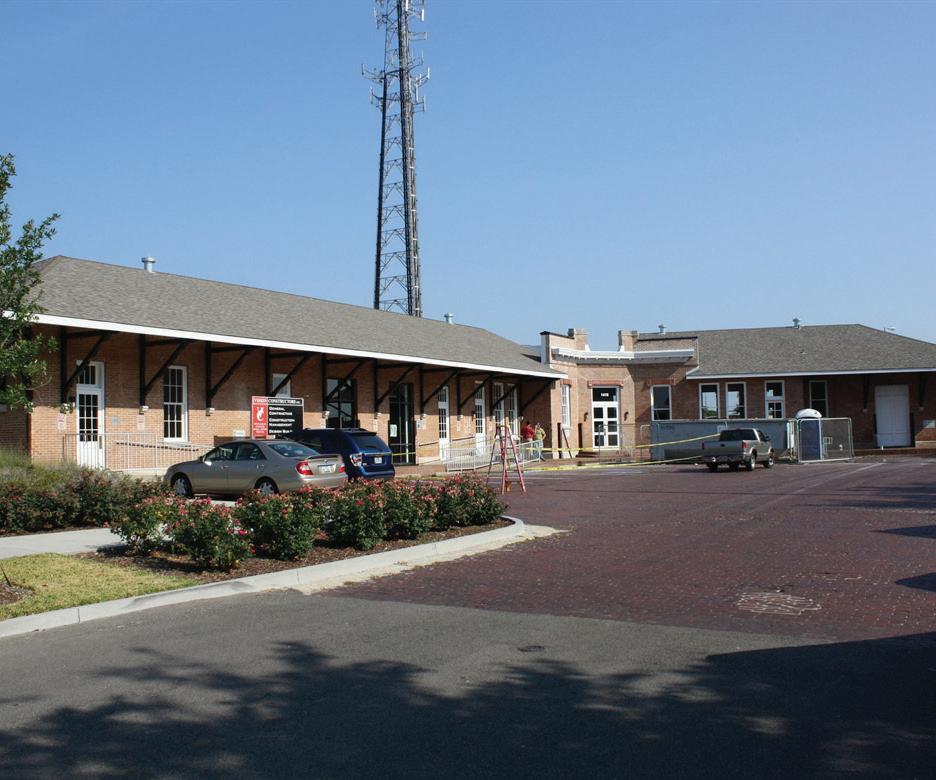
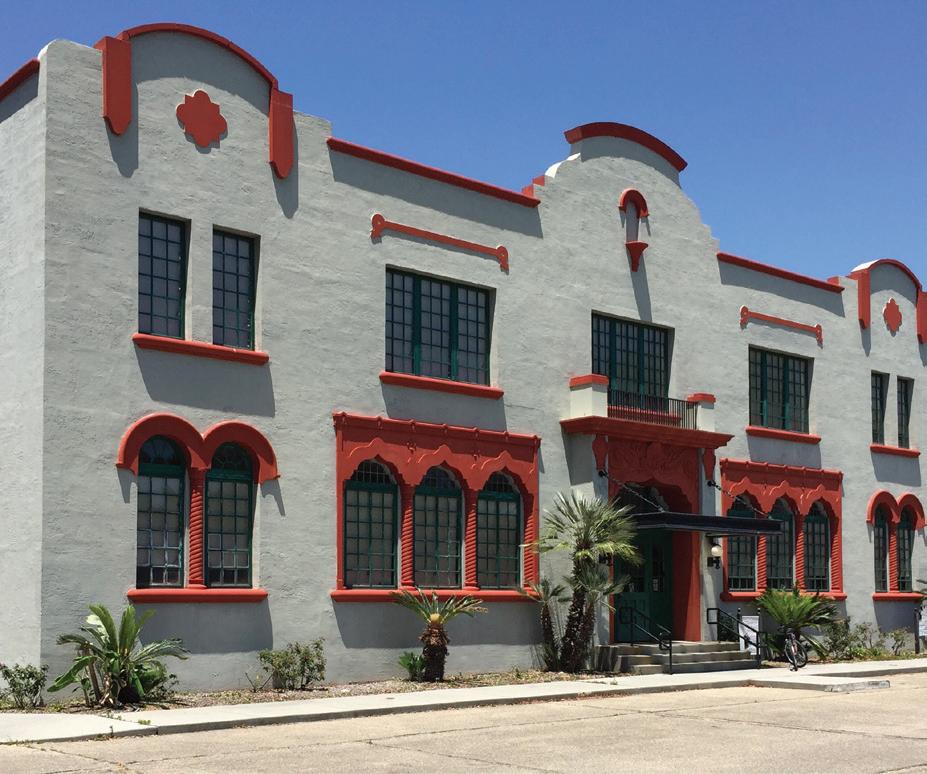
LND-MSC-0706-1430-07B
TRAIN TICKET TRAIN TICKET
PLATFORM GATE CLASSSEAT
03 06
First 07-B DATE HOUR 07/ 06 14:30 PLATFORM GATE CLASSSEAT
First 07-B DATE HOUR 07/ 06 14:30
Historical | 7
OCEAN
Our next stop is east at the Ocean Springs depot. Completed in 1908, this depot is of a design typical of the Louisville & Nashville railroad from the early 20th century and was in use as a depot until decommissioning in 1965. This depot is home to Realizations, the art shop operated by the family of Walter Anderson, and the Ocean Springs Visitor Center.

LND-MSC-0706-1430-07B
Just one town over, the Gautier depot is now a private residence that is not open to the public. Moved just a short distance from its original location, this is the only surviving 19th-century depot on the Mississippi Gulf Coast, having been constructed in 1898. Also nearby is a rare surviving Railroad Supervisor’s House, once owned by the Louisville & Nashville Railroad.


LND-MSC-0706-1430-07B
03 06
Crossing the river, we reach the Pascagoula depot. Built in 1904, this building was constructed the same year that the communities of Scranton (where the depot was located) and Pascagoula (located a mile south along the Mississippi Sound) voted to unify under the name Pascagoula. Constructed in a design typical of the Louisville & Nashville railroad from the early 20th century, the depot was once home to Pascagoula Main Street and now awaits rehabilitation for a new use.
LND-MSC-0706-1430-07B
PLATFORM GATE CLASSSEAT 03 06
First 07-B DATE HOUR 07/ 06 14:30 PLATFORM GATE CLASSSEAT
03 06
First 07-B DATE HOUR 07/ 06 14:30 PLATFORM GATE CLASSSEAT
DATE HOUR 07/ 06 14:30
First 07-B
SPRINGS GAUTIER PASCAGOULA TRAIN TICKET TRAIN TICKET TRAIN TICKET
Photo courtesy of Mississippi Department of Archives and History
8 | Embrace Your Cultural Story
Photo courtesy of Mississippi Department of Archives and History
LND-MSC-0706-1430-07B
03 06
The Wiggins depot is the second depot to be constructed by the Gulf & Ship Island Railroad for this stop; the first was destroyed in the 1910 fire that devastated the town. Designated a Mississippi Landmark in 1999, the building was moved to its present location in 2000. In 2014, the Stone County Economic Development Partnership began occupying the former depot.



LND-MSC-0706-1430-07B
LUCEDALE TRAIN TICKET TRAIN TICKET TRAIN TICKET
03 06
First 07-B
14:30
Historical | 9
PLATFORM GATE CLASSSEAT 03
06
07-B DATE HOUR 07/ 06 14:30 PLATFORM GATE CLASS SEAT
First
First 07-B DATE HOUR 07/06 14:30 PLATFORM GATE CLASSSEAT
LND-MSC-0706-1430-07B DATE HOUR 07/ 06
PICAYUNE WIGGINS
Picayune has the newest of the stops, having been constructed in 2008. If you cannot wait any longer to ride a passenger train, then head on to Picayune, because they are the only coast city with passenger rail service as of publication. Even if you don’t wish to ride the rails just yet, it’s still worth a visit as the Picayune Depot is home to the Lower Pearl River Valley Transportation Museum.
The old depot in Lucedale has ‘gone to nature’ as it now serves as an education pavilion for the Depot Creek Trail. Originally constructed as the depot for the gulf, Mobile and Northern Railroad, in 2003 the Lucedale Depot Creek Greenway opened with handicap and woodland trails as well as an educational pavilion that was inspired by the old train depot from which the site draws its name.
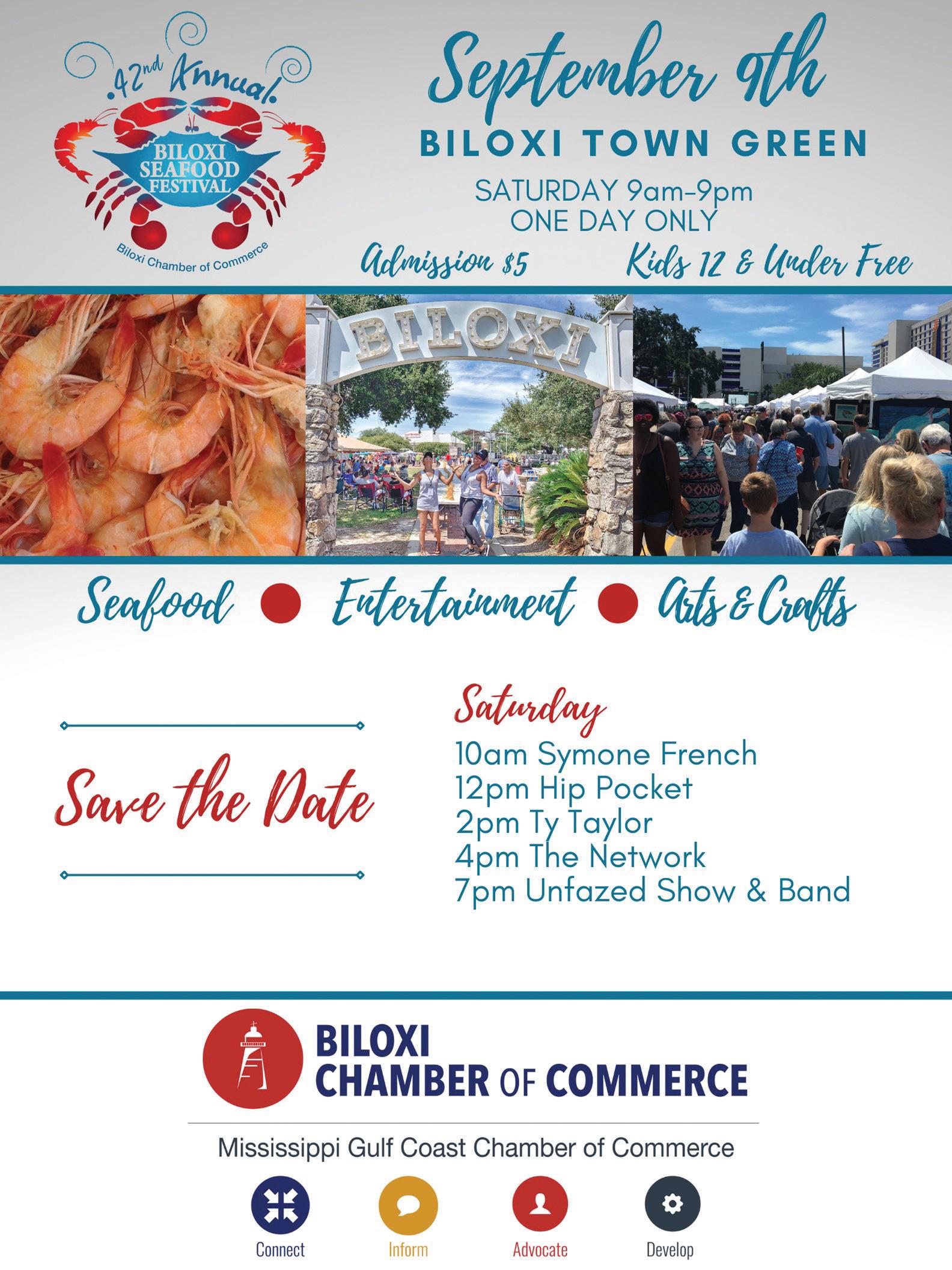
10 | Embrace Your Cultural Story
INNOVATIVE

Innovative | 11
gettin' round to Restoration
Glimpses of Round Island, three miles offshore of Pascagoula, Miss., have stirred human imaginations since the days before ships sailed the Mississippi Sound. There is much about this island’s cultural and social history that is well known, but other aspects, like its recent geological history, are a bit less defined. The recent preservation of the Round Island Lighthouse is a tribute to this image and how a community can pull together for an iconic cultural resource. Imagination may be even more important in developing support for less visible resource goals, such as restoration to offset the slow, but relentless, forces that endangered the lighthouse in the first place. Those are the rising seas and accelerating erosion that still threaten the last remnants of the island itself.
When managers at the Mississippi Department of Marine Resources (MDMR) assessed water depths (bathymetry) around Round Island in 2010, it became clear that its recent geologic history chronicles a significant transformation of shape and size. It is sometimes noted that Round Island isn’t round, but, based upon historical information beginning around 1700, she likely never was. Rather, think about a large backward capital “L” shape and a much larger one. Using an estimated sea level rise (SLR) rate of 1 ft per century, MDMR evaluated the island’s historic footprints over time. The 300-year-old shoreline, for example, would correspond to the 3-foot
depth contour on modern navigation charts. This contour traces the distinctive backward “L” far outside the present-day shoreline, showing the island has diminished from 800 acres to barely 20 acres through erosion and submergence. What remains unclear is how much the historic upland contours of the island affected its change of shape due to sea levels and how much was directly caused by erosion. This balance of coastal change over time is mirrored all along the shorelines and barrier islands of the Mississippi Sound. However, the loss of acreage for Round Island is exceptionally high compared to similar islands in the Mississippi Sound, including Deer Island near Biloxi and Isle Aux Herbes near Coden, Ala. This high loss rate prioritized the island for restoration at the largest scale possible in the context of cost and regulatory requirements and ultimately led to a restoration target of the 300-year-old island footprint.

Round Island’s dramatic transformation may have been triggered by the hurricane of 1717, which is reported in historical accounts as

12 | Embrace Your Cultural Story
Article Contributed by George Ramseur and Kate Dawson, MS, EI
separating Petit Bois Island from Dauphin Island, allowing a new breach or pass for wind and wave energy to enter the sound southeast of Round Island. The maps and charts of this period were generally inaccurate. One of the best early maps that depicts Round Island in any detail, the 1732 map below, still has significant errors. While this map clearly illustrates “Isle Ronde” as a reverse “L” (circled), this map doesn’t indicate the breach in Dauphin Island with Petit Bois that should have been present. However, the overall shape of “Isle Ronde,” as depicted here, helps confirm that the shape estimated through comparison of SLR and modern navigation data was reasonable.
Regardless, the island began to change, retaining its “L” shape at 800-acres around year 1800 on the next image (green line), then rapidly shrinking to a “tadpole” of about 130-acres by 1900 (red line). This 2022-based image also illustrates the remaining 20-acres of original island (inside the red line) and the New Round Island restoration project (bordered by the yellow line).

Restoration at this scale grew out of MDMR’s early 2000 efforts to build a beneficial use (BU) of dredged material program to leverage the enormous resource value of materials being dredged for navigation and development. Recycling these materials is the most basic step toward strategic management of the shorelines and islands that form our coastal estuaries and protect our communities. It is also the most ecologically and financially sound way to offset broader impacts of dredging, such as bank erosion, altered hydrology and barrier island erosion. Though dredging is an essential part of modern society, like maintaining highways, these broader impacts are not traditionally offset except through effective BU programs.
Initially, restoration implementation at Round Island had an advantage because its historic footprint rests almost entirely

on sand shoals. This sand could be efficiently moved to the edges of the shoals to form berm, protecting dredged materials placed inside while marsh and other habitats developed. Typical BU projects require sand or rock to be imported at great cost to provide this type of protection and meet environmental regulations. The permit for New Round Island was issued to MDMR in 2013. It was funded by the National Fish and Wildlife Foundation through the Mississippi Department of Environmental Quality in 2016. The berm was completed to its 220-acre perimeter in time to receive over 3 million cubic yards of material pumped in from the Pascagoula Ship Channel by the Mobile Corps District (Corps). The Corps and Port of Pascagoula covered the cost of delivering this material, saving about 30 million dollars compared to ocean disposal. The project has survived direct impacts from major storms, particularly Nate in 2017, and its habitats continue to develop and thrive (see below image). The recent incorporation of the original island into state ownership in the Coastal Preserves program will now enable the rest of the 800- acre footprint to be restored in time.
The need for these projects is high. Mississippi loses over 200 acres annually and has dredged enough material in a single year (over 15 million cubic yards) to have supported 1,500 acres worth of restoration. However, restoration by all state and federal partners is averaging well under 50 acres annually and significant amounts of dredged materials are still being discarded. Projects like New Round Island with its unique historic basis, and on-site sand, are an exception. Mississippi’s BU efforts will need broad public support to continue developing projects which leverage natural materials and processes to keep our dredged materials “in the system” to support our natural resources.
Innovative | 13
Photos contribution is Google Earth and Round Island Lighthouse
the R/V Conservationist
historic lugger continues enhancing oyster population

The Mississippi Gulf Coast has had a long and storied history as a producer of fresh, succulent seafood for many generations. In addition to this, the area’s shipbuilding industry has also become a vital part of the local culture. Throughout the years, the Mississippi Department of Marine Resources (MDMR) has been an integral part of this cultural fabric in its efforts to enhance, protect and conserve the state’s marine resources. One of MDMR’s most prized assets, and serving as the agency’s flagship, the research vessel (R/V) Conservationist is at the very center of this nexus with the seafood industry, boatbuilding tradition and the public benefit provided by the MDMR’s Shellfish Bureau to preserve our natural resources and our way of life.
Built in 1972 by the regionally acclaimed Covacevich Shipbuilding company in Biloxi, Miss., the R/V Conservationist is a 65-foot steel hull oyster lugger that has served the state agency well for more than 50 years. Like most contemporary oyster luggers found in the industry today, the R/V Conservationist is a shallow draft, single screw (one engine), diesel-powered workboat designed to ply the shallow waters of the Mississippi Sound and look good doing it. The graceful, iconic lines of the R/V Conservationist convey a sense of timelessness here on the Gulf Coast with its form etched into our subconscious as what one would expect a fishing boat to look like in coastal Mississippi. With a capacity to carry well over 1,000 sacks of oysters, this vessel has been an indispensable tool in the state’s endeavor to maintain and build oyster reefs from the mouth of the Pearl River in the west to the Pascagoula watershed in the east.

14 | Embrace Your Cultural Story
Words and Photos by Andrew Barrett
One responsibility of the R/V Conservationist is promoting new reef growth, primarily through cultch planting and reef cultivation. This is the process of enhancing existing oyster reefs by deploying materials that will promote the settlement of oyster spat (juvenile oysters) on clean substrate across the reef. Oyster spat generally spend a few weeks navigating the water column before settling to the bottom and attaching themselves to an existing oyster or another piece of hard material on the reef. As oysters are harvested from their natural oyster beds, the shell material is removed from the reef when the oysters go to market. Without replenishing the reefs with fresh material, eventually, the oyster spat in the water column would have no place to settle and attach; an essential process that insures the growth of the next generation of oysters. Using materials, such as oyster shell, crushed concrete or even limestone, the R/V Conservationist, for decades, has been loaded with tons of cultch material and sent to every corner of state marine waters to help maintain and grow the oyster resource. Once at the designated deployment site, the material is either shoveled overboard or blown off the boat using large water cannons, similar to those found on a fire truck. Any experienced hand on an oyster boat who has had the pleasure of shoveling cultch material for a full day truly knows the value of a lugger’s water cannon system.
Another responsibility appointed to the R/V Conservationist in its state service, is reef cultivation, the process of turning over existing oyster reefs, much like you would till the ground before planting a garden. To cultivate a reef, the R/V Conservationist is outfitted with large commercial oyster dredges with removed catch bags. When deployed to the bottom, the dredges will rake across the reef, flipping and turning oysters and shells to clean the silt and debris that has settled on the reef over time. This provides for a cleaner, more acceptable surface for oyster spat to settle and attach. Reef cultivation is most effective when done just before the annual oyster spawning cycle. Typically, in Mississippi waters, late spring to early summer is the best window of opportunity for cultivation in advance of a July spawning cycle. Cultivation also aids in breaking up large clusters of oysters and spreads them more evenly across the reef. Another benefit of reef cultivation is the control of the hooked mussel population. Hooked mussels are a variety of bivalve that grows on top of reefs, choking the oyster population off from needed space and nutrients. Their purplish-black shells are relatively thin and fragile and are easily destroyed when encountered by an oyster dredge weighing as much as 115 pounds.

Innovative | 15
However, the R/V Conservationist’s duties are not limited to cultch planting and reef cultivation. Oyster relays are another common assignment of this celebrated vessel. An oyster relay is a process of dredging living oysters from the waters of one area and redeploying them in another. This may be done to provide oyster brood stock to a particular reef area or to relocate market-sized oysters from areas with poorer water quality to areas of greater water quality. Because oysters are filter feeders, they will, in a relatively short time, purge themselves of impurities once placed in cleaner waters and could eventually be harvested for consumption if all regulatory conditions are met. This self-cleansing process is known as oyster depuration and is commonly used in states with an oyster industry.


The R/V Conservationist is also used at the MDMR to deploy spat-on-shell and Oyster Gardening materials in areas along the Gulf Coast. The MDMR spat-on-shell program consists of growing oysters in a controlled environment, such as large holding tanks. Within these tanks, repurposed oyster shells are used as a setting material to grow oyster spat that were spawned in an oyster hatchery. Once the oyster spat reach a certain size, the holding tank contents are transferred to the deck of the R/V Conservationist and deployed on Mississippi’s oyster reefs. The Oyster Gardening program is similar in that spat is grown on repurposed shell, but they may be grown out before deployment in bags or containers off a pier or dock. This program is unique as it involves participants, such as Mississippi residents or high school science programs, to grow and monitor these oysters before handing them over to the MDMR for deployment. Both involving the public and utilizing the program as part of an educational curriculum have helped to inform the community and the next generation of the importance of a healthy, balanced ecosystem.
For many years now, the R/V Conservationist has played a key role in the development and maintenance of Mississippi’s oyster resources, and employees past and present have delighted in the opportunity to serve on this esteemed vessel. From its construction at the Covacevich shipyard in Back Bay Biloxi to its years of faithful service along the Mississippi coast, the R/V Conservationist has become an iconic symbol of the MDMR's dedication to oyster conservation and a beloved part of Mississippi's maritime heritage.

16 | Embrace Your Cultural Story
Photos courtesy of Andrew Barrett and MDMR





Innovative | 17
NATURAL
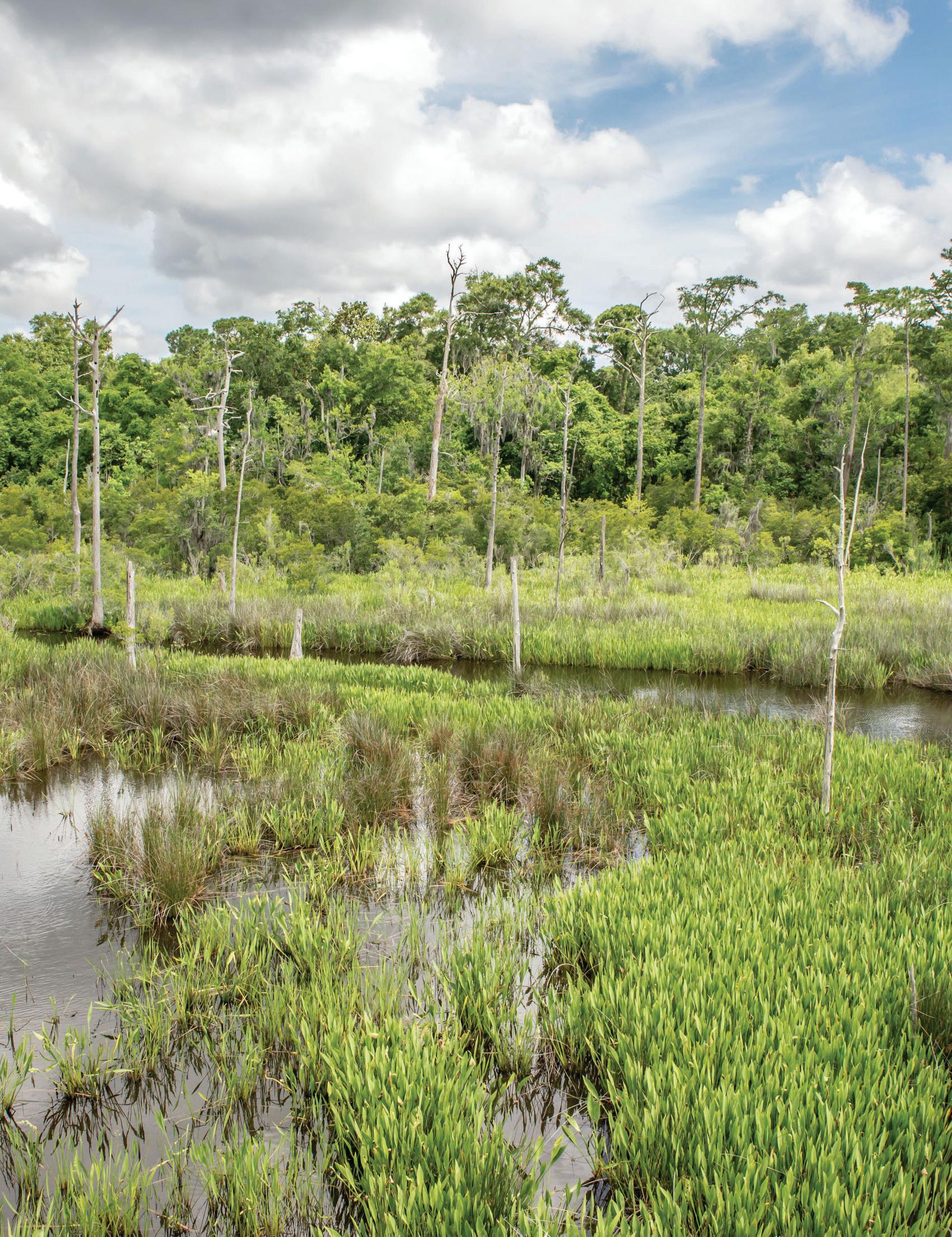
18 | Embrace Your Cultural Story
BLUEWAY SPOTLIGHT GRASSY POINT
As part of the Mississippi Gulf Coast National Heritage Area’s Nature Based Tourism effort, the Blueways program was established to provide explorers an unforgettable experience along miles of beaches, rivers, creeks and bayous. There are currently 15 Blueways, or water trails, that have been mapped out for recreational canoers and kayakers within the six coastal counties in Mississippi. Here is a quick look at the Grassy Point Blueway in Hancock and Harrison Counties.



The Grassy Point Blueway is located along the northern shore of the St. Louis Bay in both Hancock and Harrison counties. Beginning in Pass Christian, at the Marlin Necaise Public Boat Launch on the Wolf River, the water trail heads west into the St. Louis Bay just below Delisle, Miss. Aiming for the southern point of the Grassy Point peninsula, the namesake of this blueway, the trail continues west towards Diamondhead. On the west side of the St. Louis Bay, the trail enters Cutoff Bayou just south of Diamondhead and north of the Jourdan River. Approximately three-quarters of a mile up Cutoff Bayou is a major tributary on the right that will lead you to the terminus of the Grassy Point Blueway at the Diamondhead Marina after about a 1 and one-quarter mile paddle. From beginning to end, the blueway is roughly a 10.2-mile trip, and it is suggested for paddlers with at least an
intermediate level of experience. Much of the journey is in the open waters of the St. Louis Bay, and boating traffic should be taken into consideration. Strong winds from the south can create an appreciable chop in the St. Louis Bay and a check of the weather conditions is advised when planning an outing. Both the Marlin Necaise Boat Launch and the Diamondhead Marina provide easy water access and ample public parking for boaters and paddlers alike.
Consider an estuarine system which offers a large variety of habitats for both flora and fauna, including beautiful marsh settings teeming with an abundance of song, raptor and wading birds. For anglers, this blueway offers inshore fish species including flounder, Redfish and Speckled Trout. Be sure to bring plenty of water and snacks as there are no amenities once in the open bay. The Grassy Point Blueway connects with the Wolf River Blueway to the east and the Rotten Bayou Blueway to the west for paddlers looking for their next adventure.


To learn more about the Grassy Point Blueway, or the many other coastal blueways Mississippi offers for paddlers, visit the Mississippi Gulf Coast National Heritage Area’s website at msgulfcoastheritage.ms.gov/natural/blueways/. Here you will find descriptions for all the coastal blueways, as well as downloadable PDF maps, to help plan your adventure.

PLAN YOUR ADVENTURE!d B d RdCekRd Little Bay 1 M ng A -D Rd W m vA GRASSY POINT CEDAR POINT ta 1 H H BAY ST LOUIS d t yo h h 0 1 2 10 LEVEL START/END Intermediate Necaise Boat Launch on the Wolf River/ Diamondhead Marina 10.2 miles one way 3 hours Open Water in the Bay of St Louis surrounded by Saltwater marsh Saltwater Marsh, Pines and Ancient Oaks Landscape view of the Bay of Saint Louis and the beautiful Hwy 90 bridge Public Boat Launch MAP LEGEND GRASSY POINT TRAIL Canoe/Kayak Launch Point of Interest Blueway Trail Mile Marker SCENERY ACCESS Grassy Point Trail is a 10.2 mile trip, one way to Diamondhead. Leaving from Necaise Boat Launch on the Wolf River, travel northeast/ north to DeLisle Bayou and out to St. Louis Bay. Once in the bay, this trail meanders along the marshes of northern St. Louis Bay. End the long paddle at the Marina restaurant in Diamondhead where you may enjoy refreshments, lunch or dinner and see the beautiful view of St. Louis Bay from the decks. Kayak rentals are available at this site 0 2mile 1 TRAIL MILES PADDLING TIME DESCRIPTION Points of Interest 1 Merlin Necaise Public Boat Launch 30° 55’ 69” N, 89° 27’ 31” W 2 Diamondhead Marina
Words by Andrew Barrett
Natural | 19
Saturday, June 24th 8 AM to 2 PM
Henderson Point Park at the base of the Bay Bridge in Pass Christian
Paddle the Bay or around the bayous, and/or Run the Road
Food, Music & Fun
WIN the gold, silver or bronze paddle with prizes by raising the most money!

https://secure.givelively.org/donate/the-rotary-charity-trust-fund/2023-rotary-of-pass-christian-paddle-the-bay-with-a-5k


Fundraiser
2023 Rotary Club of Pass Christian
20 | Embrace Your Cultural Story
COMMUNITY
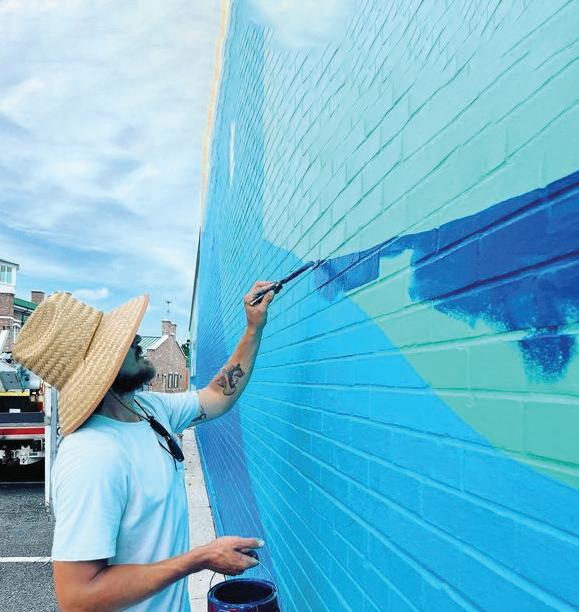
Community | 21
By RoxAnn Rankin Wicker
STREETSCAPE: MURALS ALONG THE COAST



22 | Embrace Your Cultural Story
On a quest to visit our Main Streets of Coastal Mississippi, I found various cheerful, colorful, engaging murals that sparked my curiosity. Appearing like a billboard of artistry, laden with messages of love and hope, paralleled with a movement for advertisement of creativity, these murals are sure to capture the public.

Turns out there are various historic and newer buildings with blank facades that have been transformed into spectacular art pieces. Thankfully, the property owners were willing to have these murals added to their buildings. Some of the murals were temporary, meaning, on a surface that would not compromise the integrity of the building with drilling or destroying the brick or wooden structure.
Here along the Mississippi Gulf Coast, there are various hybrids of themed artwork from coastal, street art, wood carvings, pop art, all coming together in a very dynamic and interesting way.


Community | 23
It began on a drive into downtown Bay St. Louis. I saw the beautiful heart piece along the side of a chimney at 211 Main Street. Then down the way to The Shops of Century Hall was a beautiful coastal mermaid rendering by Holly Garvin. This reminded me of the vibrancy of the 100 Men Hall mural that was created by Wendo and JoLean through a grant with the Mississippi Gulf Coast National Heritage Area program. As I left the beautiful, quaint town, I stopped off at the infamous Mockingbird Café where I found “All Are Welcome Here,” by Ann Madden



24 | Embrace Your Cultural Story
If you’re traveling to downtown Biloxi, you will find a gorgeous strip of the Vieux Marche with freestanding art and murals alike. If art is what you are after, you will find our state flower adorning the side of the Gallery 782 building. Howard Avenue provides a multitude of artistry murals by Mr. Cali Rob, a favorite and local muralist. He has “Gulf Coast Strong” and the “Greetings from Biloxi” postcard mural that welcomes you to the revival of downtown. Further to the west along Howard Avenue, artist Niko provides a glimpse of the beautifully, but hauntingly magical, “The Casquette Girls.”





Community | 25




26 | Embrace Your Cultural Story
Crooked Feather welcomes you to Ocean Springs from Biloxi with his handsomely carved stare. And while in Ocean Springs, you could visit the “Art in the Open Installation: Monarch” while you take in a stroll through the Charnley Norwood House at 509 East Beach.


If murals aren’t your thing, there are freestanding sculptures scattered about the Mississippi Gulf Coast. The heartfelt “Katrina Memorial” can be found at 133 Main Street in Biloxi and the Marshall Jesus Sculpture is located at 438 Silver Ridge in Gulfport.

Community | 27
Recently, Ocean Springs found itself without a mascot. Once more, the beloved rooster that roamed their downtown tragically died this past April. Carl 2.0 will forever live on in the hearts of their community and the visitors alike in part to a mural that artist, Mr. Cali Rob, donated to the city.


When asked about the significance of the painting, he said, “I wanted to give something back to Ocean Springs after losing Carl. If nothing else, I hope it reminds everyone to be kind and gentle, but mostly to love.”

28 | Embrace Your Cultural Story
East Jackson County serves the art community with sculptures and art murals, respectively. In Pascagoula, a look back at the enchanted landscapes and historic landmarks provides a depiction by muralist Mary Bet Evans. Additionally, Moss Point, also known as the River City, has an abundance of art murals on the books. The mural on Main Street which features a River City waterways rendition. Both the Pascagoula River Audubon Center and the Grand Bay National Estuarine Research Reserve (NERR) feature “Art in the Open Installation: Flower, Pascagoula Audubon and Pine Tree Design at Grand Bay NERR.”




Community | 29
Monarch Flower Medallion Pine Tree design
BAY ST. LOUIS
History of Old Town Bay St Louis
John McDonald, Artist
Back of Hancock Bank Building, Beach & Main St.
Ruth's Roots Community Garden
Various Artist
130 Court Street
Fleurty Girl Boutique
Suzie Brown, Artist 216 Main St.
All Are Welcome Here
Ann Madden, Artist
110 South Second St.
Love International
Andrew Switzer, Artist
200 Main St.
Love Chimney
Marian Glasser, Artist 211 Main St.
Coca Cola Mural
Unknown Artist 220 Main St.
BILOXI
Magnolia's Unknown Artist
769 Jackson St.
Monarch Butterfly
Tricia McAlvain, Artist
770 Water St. (parking lot)
George Ohr Mural
Zach DePolo, Artist
Mary Mahoney's, 138 Rue Magnolia
Mardi Gras Queen's Gown
Katherine Rushton, Artist
Mardi Gras Museum, 792A Howard Ave.
Love is Love
MrCaliRob, Artist 906 Division St.
The Casquette Girls Niko, Artist 871 Howard Ave.
Adventure Wave
MrCaliRob, Artist Adventures Pub 132 Lameuse St.
Inez Thomas Café-Wade Ins Mural
Demetrius Gayden, Artist Corner of Main & Division St.
Love Is All We Knead
MrCaliRob. Artist 280 Oak St.
GULFPORT
Chandeleur Island Brewing Co.
Tricia McAlvain, Artist 2711 14th St.
Aquarium
Robert Waldrop, Artist 2401 14th St.
Fishbone Alley
Various Artist 1609 14th St.
Greetings from Gulfport
Jerika Broussard
15th St.
Lighthouse Magnolia
Unknown Artist 2415 14t St.
Frida Kahlo
Cody Bryan Richardson, Artist Corner of 21st and 25th Ave.
MOSS POINT
Greetings from Moss Point River Prince, Artist Masonic Lodge, Corner of Main St.
Welcome to the River City
Unknown Artist Main St.
OCEAN SPRINGS
Carl 2.0 Rooster
MrCaliRob, Artist Wild Flier, 1018 Government St.
Turquoise Eagle
MrCaliRob, Artist Bienville Blvd.
Sculpture of Crooked Feather
Thomas King, Artist
Ocean Springs Entrance Bienville Blvd.
PASCAGOULA
Celebrations of the Coast
Alan Watson, Artist City Hall, Rear Entrance
Block Art
Pascagoula High School Students
Delmas Ave.
Legend of Singing River
Various Artists
Pascagoula Public Library
WHEN IT COMES TO DISCOVERING SECRET CANVASES, YOU ARE SURE TO FIND ONE ON DISPLAY, OR IN THE WORKS, TO REPRESENT AN EXPLORATION ON HOW WE FEEL AND MOVE THROUGH EACH CITY ALONG THE MISSISSIPPI GULF COAST.
30 | Embrace Your Cultural Story
Outpost Spotlight


Community | 31
The Gulf Coast Outpost business recognition program is part of the 2016 Nature-Based Tourism Plan for Coastal Mississippi. It was developed for the Heritage Area by stakeholders in the industry. Business owners and operators are recognized through a checklist that focuses on training, sustainability and stewardship. The program is aimed at those companies whose primary business is dependent on the natural environment in Mississippi’s six coastal counties. This includes businesses such as eco-tourism companies, locally owned outfitters, charter boat operators, tour guides, eco-lodges and agritourism entities.
Words by Andrew Barrett
In this addition of the Gulf Coast Outpost (GCO) Business Spotlight, we are featuring a business out of Ocean Springs, Miss., called Food, Booze & Hiccups. With such a unique name, it should be expected that the owners, too, have a unique mindset and innovative approach to their business model. Owners Stephanie and Michael Paoletti do in fact bring a sort of unparalleled modus operandi to their ever-evolving line of businesses in the culinary arts and under the Food, Booze & Hiccups banner, a multitude of dining adventures awaits.
Although they offer catering services for almost any occasion, to say Food, Booze & Hiccups is simply a catering company would be an injustice to the Paolettis’ creative venture and culinary passions. What makes their company so extraordinary is the pure number of inventive options in both locale and in-menu items.

One popular option for dining is their outdoor pop-up restaurant called “The Lot.” Situated in downtown Ocean Springs at 1401 Government Street, The Lot is ideal for executing an exquisite menu in a laid-back, picturesque atmosphere. Food, Booze & Hiccups incorporates both locally sourced and exotic ingredients and serves on some beautiful, locally crafted pottery by Gulf Coast artists. Think of it as fine dining that’s a little UN-refined. Guests can select a date and book their own private party or select one of their themed events.

 Photos courtesy of Food, Booze & Hiccups
Photo courtesy of Jesse Johnson
Photo courtesy of Jesse Johnson
Photos courtesy of Food, Booze & Hiccups
Photo courtesy of Jesse Johnson
Photo courtesy of Jesse Johnson
32 | Embrace Your Cultural Story
Another ingenious alternative is their “Belly Up Beach Chairs” experience for dining on the beach. Food, Booze & Hiccups will arrange the beach chairs, queue up the music, set up a charcuterie and even provide the bonfire. All you have to do is show up, relax and enjoy some of the best views along the coast. They even pull all the permits. This service comes with options for menu items, and they have recently added a “Brunch on the Beach” for those looking for a daytime outing.
In addition to the previously mentioned options, Food, Booze & Hiccups will travel to your chosen location. Whether it’s a private dinner at your home, a huge wedding or a fun and funky birthday party, Food, Booze & Hiccups can provide a catering experience for your gathering that will leave a lasting impression on you and your guest.

For those of us with a sweet tooth, Food, Booze & Hiccups has a brick-and-mortar location in Ocean Springs called Sweet Enchantments. Located at 1056 Thorn Avenue, Sweet Enchantments is a scratch bakery that specializes in occasion cakes, macarons, cookies, confections, ice cream, allergen-free products and even grab-and-go breakfast and lunch. Future plans for a Butcher Baker shop in a European tradition are in the works and, coming soon, meats cut from whole animals, cured meats and cheeses will all be available under the Food, Booze & Hiccups offerings.
If all that isn’t enough for you, Food, Booze & Hiccups can even provide cooking classes in a one-on-one setting at their Sweet Enchantments locations or at a venue of your choice. So, if you are in the market for a unique dining experience, in need of a first-rate caterer or simply want to learn a few culinary cues from the very best, Stephanie and Michael Paoletti at Food, Booze & Hiccups can definitely deliver. To learn more about their many offerings, visit fbhos.com/, the Sweet Enchantments Facebook page at facebook.com/ SweetEnchantmentsCakes/ or call 228-382-0970 or 601-299-3152.



 Photos courtesy of Food, Booze & Hiccups
Photos courtesy of Food, Booze & Hiccups
Photo courtesy of Jesse Johnson
Photo courtesy of Jesse Johnson
Photos courtesy of Food, Booze & Hiccups
Photos courtesy of Food, Booze & Hiccups
Photo courtesy of Jesse Johnson
Photo courtesy of Jesse Johnson
Community | 33
Photo courtesy of Jesse Johnson
LIFE
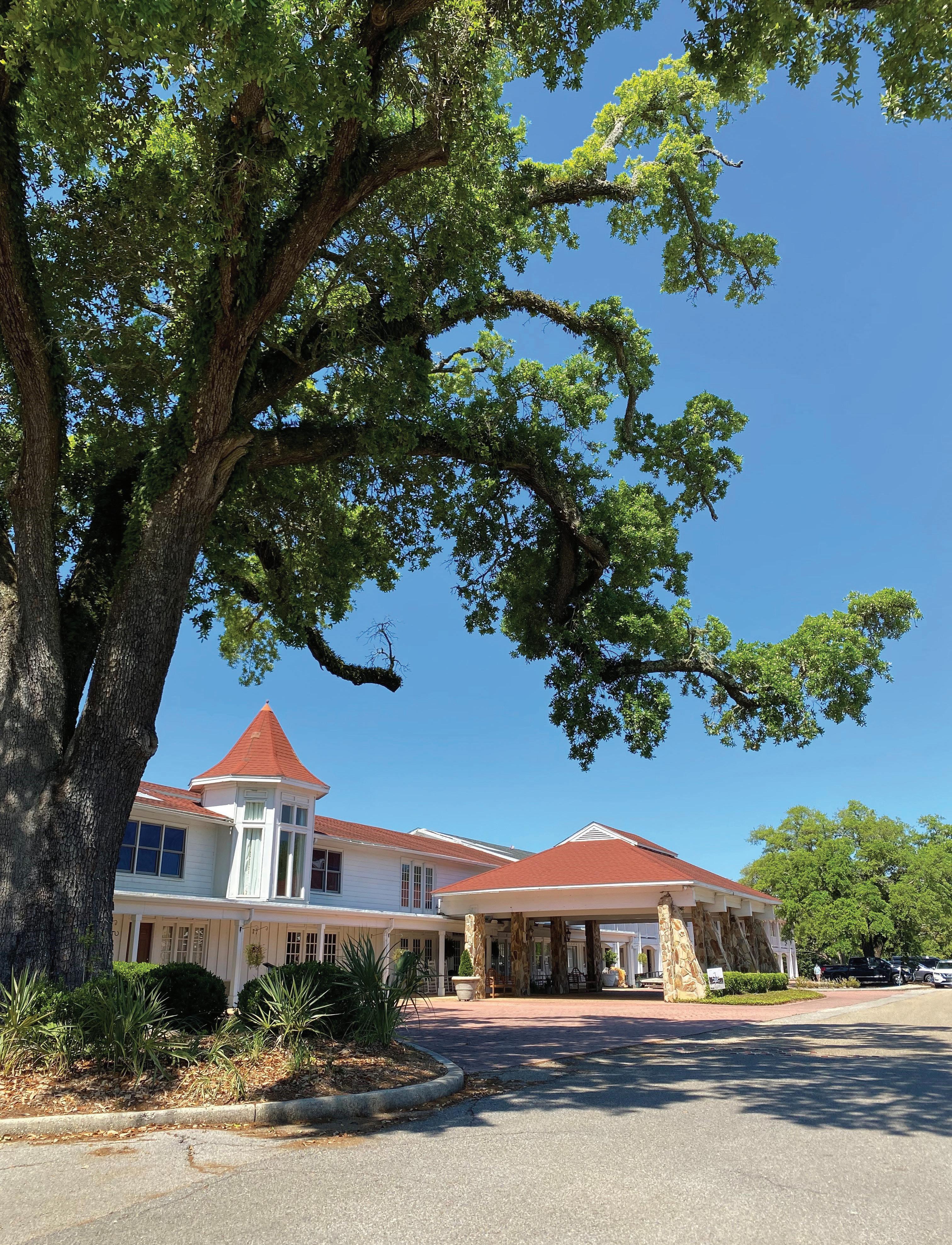
34 | Embrace Your Cultural Story
The Course to Gulf Hills
Article and Photo Contribution by Ray Bellande
Clarence Wallace Gormly, (1882-1957) was an attorney, land developer and resort builder from New York. Gormly was married to Eleanor Meredith (1883-1962) probably a native of Larchmont, New York, and they had three children (pictured above). The Gormly’s never actually planned to stay for any notable timeframe, just long enough to develop a few areas on the Gulf Coast and move onward.

Between 1925 and 1930, Mr. and Mrs. Gormly worked diligently on Gulf Hills, Belle Fontaine and Pointe aux Chene, which are known landmark areas of Ocean Springs.

Gulf Hills is a resort and real estate development with an eighteen-hole golf course located just north of Ocean Springs, Miss. The area provides mesmerizing backdrops whilst the waters off Old Fort Bayou host a pleasant breeze and deliver uninterrupted sunsets to boast. The golf course contains several elevated tee shots that are as scenic as they are memorable.
In April 1925, The Jackson County Times related that “C.W. Gormley (sic) has acquired additional acreage across the bayou adjoining the Applegate (sic) place for the proposed country club and golf links.” Mr. Gormly also acquired about 16 acres from H.F. Russell and son across Old Fort Bayou adjacent to the Andrew Olson place. The vision was to elevate the surrounding area to the prominence of New Orleanians by establishing a resort community.
Prior to the incorporation of Gulf Hills, the Gormlys acquired several hundred acres in the area north of Old Fort bayou, which would become a part of the development. They appear to have been working with Allan B. Crowder to consolidate about 700-acres of rolling, pine lands bordered by Bayou Puerto on the west and Old Fort Bayou to the south.

Due in part to Gormly’s determination and development plan, Gulf Hills was incorporated in the State of Mississippi in mid-September 1925 by the following men: Allan B. Crowder of Pass Christian, Miss.; William E. Applegate of Ocean Springs; Clarence W. Gormly of Ocean Springs; Ralph R. Root of Chicago, Ill.; and Harvey W. Branigar (1875-1953) of Chicago.

Life | 35
DEVELOPMENT
In October 1925, Gormly and W.E. Applegate Jr. (1876-1948) traveled to Chicago to meet with the other incorporators of Gulf Hills to perfect plans for development of the property. Construction at Gulf Hills began in May 1925. At this time, a labor crew was using dynamite to clear the topography so the construction of the clubhouse and golf course could commence. By late September of that year, over 100 workers were employed to construct the golf course, club house and other improvements.
THE GOLF COURSE
By June 1925, the first nine fairways of the planned 18-hole golf course at Gulf Hills had been cleared of trees and underbrush. Golf course architect, Jack Daray (1881-1958) of Olympia Fields, Chicago, oversaw the operation. Landscape architects Root & Hollister of Chicago planned the roads, parks and clubhouse grounds. In addition to the waterfront and golf course, residential lots were surveyed and platted. Building covenants were established regarding use and cost. Homeowners had golf course privileges for themselves, their families and houseguests.
OPENING DAY-JANUARY 15, 1927
Prior to and preceding the formal opening of The Gulf Hills Country Club on January 15, 1927, the Mississippi Gulf Coast was the scene of several other grand events that same month. The Edgewater Hotel opened on January 10, followed by the formal opening of the Biloxi-D’Iberville bridge on January 12. The Tivoli Hotel, designed by Carl Mathes, opened the following month on February 19.
At Gulf Hills, several thousand people were invited to the ceremony. A 36-hole medal play golf tournament was held.
GORMLY LAUDED
In March 1927, Clarence W. Gormly was praised as follows: “Most credit for the success of the Mississippi Gulf Coast is due to C.W. Gormly, the genius behind Pine Hills, Gulf Hills and other developments. And now Mr. Gormly is developing Point aux Chenes, which means Point of Oaks. This will soon be a development of first importance. No one appreciative of natural beauty and a sloping white sand beach overlooking the broad expanse of the waters of the Mississippi Sound, can doubt. Mr. Gormly, inspired by the vision of this 2,000 acres in Point aux Chenes future, is fired with a pioneer spirit that has built America, is creating an earthly paradise along the white beach shores and rolling land among the stately pines, oaks and magnolia trees.” (The Jackson County Times, March 5, 1927, p. 2)
SHELL BEACH
Shell Beach-on-the Bay was located on the north shore of St. Louis Bay about 2 and one-half miles as the crow flies from the town of Bay St. Louis, Harrison County, Miss. In 1923-1924, at Shell Beach on-the-Bay, Gormly’s company built the Mexican Gulf Country Club, an 18-hole course with country club, for about $125,000. Root & Hollister designed and landscaped the course and environs. They would later participate in the construction of Gulf Hills. This 2000-acre picturesque, elevated tract was sold to a New Orleans syndicate represented by Latter and Blum for a sum of more than $300,000. The Mexican Gulf Country Club, a 6,500-yard par 73 golf course was included in the sale. It was anticipated that a movie studio to rival Hollywood would be located on the premises.
1934-THE BILOXI COUNTRY CLUB

In January 1934, Gormly leased the Biloxi Golf Club and planned to incorporate it as the Biloxi Country Club. The Biloxi Golf Club had been founded in May 1918, by a group of wealthy Biloxi citizens led by Edward Brady (1867-1939), John J. Kennedy (1875-1949) and Elbert L. Dukate. Its membership included such local notables as: John W. Apperson (1862-1939), Byrd Enochs (1875-1940), Lyman Bradford (1863-1944), Walter E. White (1891-1940), Louis B. Joyner (1889-1926) and James C. Elmer (1888-1920). The Biloxi Golf Club had a capital stock of $30,000, which was increased to $50,000, in March 1925.

The Biloxi Golf Club was situated on a 110-acre tract acquired from Cora E. White (1864-1934) in northwest Biloxi. Construction of the golf course commenced in mid-March 1918, under the supervision of golf professional, Jack Daray of Grand Rapids, Mich. In 1941, the course and clubhouse became integrated into the new Army Air Corps training school, which was later named Keesler Air Force Base.
CLOSING
The development of sparsely inhabited land by Iberian and other pioneer settlers in the mid-19th century became the creation of a well-established, sought after, historic golfing and residential community. Men like C.W. Gormly and the Branigar brothers of Chicago envisioned and erected in the mid-1920s, a fine golf course with amenities and a unique Spanish Revival architectural community situated on Old Fort Bayou. The resort was ecofriendly and in complete harmony with the natural environment and has remained so for almost a century.
Caught in the calamity of the Depression, Clarence W. Gormly and family departed the Mississippi Gulf Coast circa 1935 for south Florida. He settled in Kendall, Fla., where he worked as a salesman for the Keys Realty Company and raised fruit trees as an avocation. C.W. Gormly died in October 1957. Mrs. Eleanor M. Gormly lived until February 1962.
36 | Embrace Your Cultural Story
FLAVORFUL

Flavorful | 37
They say sometimes you receive little winks from heaven, and on a trip to Edd's Drive-In, I couldn’t agree more. You’ll need to do your penance before taking down these heavenly treats. A staple in Pascagoula serves up the Holy Trinity of meat, cheese and bread! Well, that’s not really the Holy Trinity, but it works in this case.


Edd’s Drive-In started out as a Dairy Queen in 1953 by Ed McElroy. Quickly earning a reputation for value and quality, the burgers and milkshakes were a local favorite. Don Dean bought the establishment from McElroy and kept the tradition consistent. In 2001, a local family group, Foster-Martin Family Enterprises, LLC, assumed ownership with the intent to remain true to the legacy and tradition.

As a child, the amazement never left me. I would watch as people arrived in droves after work and the staff would remember orders by memory, and count money in their heads. Yep, no calculators or debit card machines in those days. Good, old-fashioned elephant memory and arithmetic. In those days, I would arrive and was almost always greeted by Miss Debbie. She would see me with my Daddy and would instantly say, “Hey, Baby.” I thought I was so special. Miss Debbie would always greet me and my Daddy with a smile and send me off with a hand-dipped cone that would relentlessly get me in a heap for the mess it made after melting, but it did not deter my enthusiasm.













































For as long as I can remember the hand-dipped chocolate cones, and chili cheeseburgersin that order - have been my favorite. I like the sloppiness of the chili that oozes out with each bite, and the best part of chili cheeseburgers at Edd’s must be the chili that melts into the bottom of the wrapper paper. At the completion of each chili cheeseburger is this little token of bliss just waiting for you to devour, and look, if you’re not licking the bottom of the wrapper to make sure you get every ounce of that gold, then we just can’t be friends. But just as much as I love those chili cheeseburgers are their hand-dipped cones. From the moment Miss Debbie would hand it to me, it was melting. My face would be covered in chocolate, the cone would act as a hand towel, however, within minutes it would be one big mess. Looking back, I would not trade the memories and the scolding for a jewel in my crown.

Today, Edd’s is still serving up its chili cheeseburgers, chili cheese hot dogs, shakes, dipped cones and special hamburgers, but a lot has changed since those days of innocence. With Foster-Martin Family Enterprises, LLC, purchasing the local walkup restaurant in 2001 came new, improved, streamlined ordering. Eventually, they traded in their memory bank for up-to-date technology, installing a point-of-sale system, accepting debit cards and jumping on the bandwagon of online ordering. The faces and the daily processes may have changed in the last 35 years from my countertop welcome from Miss Debbie, but the food and memories remain embedded in my soul.


38 | Embrace Your Cultural Story
Words by RoxAnn Rankin Wicker
Hummingbird Cake
WORDS BY ROXANN RANKIN WICKER
According to the southern etiquette Bible, aka Southern Living Magazine, the Hummingbird Cake is the epitome of the “Southern Cake.” It was submitted by Mrs. L.H. Wiggins of Greensboro, N.C., in 1978. Who knew this simple, yet revered cake would become a staple at birthdays, bridal showers or, the newest craze, ‘Sip & See?’ This is the new-age post-baby shower for a mother and her baby that involves the occasional alcoholic and non-alcoholic beverage while we all “ooh and ahh” over the baby while the mama can enjoy some adult stimulation from her favorite gals and maybe a little sip of something to ‘raise her spirits.’
My heart beats like a pair of wings for this cake each time it is offered. Likely because it is loaded with vegetable oil making it super moist to one’s liking, the texture of the cake batter is more like a soft, buttery bread instead of a generic cake mix. But the star of the show is the juice from the entire can of crushed pineapple combined with the cream cheese icing. As we say here in the south, “My Lord have mercy, just slap me now.” Meaning, it is the best thing on this side of the Mason-Dixon.
This beloved cake recipe is rather simple. The key to the best Hummingbird Cake is using ripe bananas. The three-layer cake takes on a tropical flavor when baked. The cinnamon, pineapple, chopped bananas and toasted pecans send your senses to a warm, nutty flavor. Mrs. Wiggins paired it with homemade cream cheese icing and, boy, are we grateful for that combination. Once you enjoy the flavor combinations, you can create your own theory of how the name came about, whether it is sweet as nectar or creates a hum in your palate.
Recipe courtesy of Stephanie Paoletti, co-owner, Food, Booze & Hiccups
HUMMINGBIRD CAKE WITH CREAM CHEESE ICING ( Yields two 8-inch cakes)
Ingredients:
3 whole Eggs
¼ cup Canola oil
2 teaspoons Vanilla extract
8 ounces Pineapple with pineapple juice, canned, diced
2 cups Bananas, very ripe, mashed
3 cups All-purpose flour
2 cups Granulated sugar
1 teaspoon Baking soda
½ teaspoon Kosher salt
1 teaspoon Cinnamon, ground
2 cups Pecans, toasted and chopped
Method:
1. Mix together eggs, oil, vanilla and pineapple juice in a bowl with a hand mixer, or in a mixer with a whip attachment.
2. Add mashed bananas.
3. In a separate bowl, combine flour, sugar, baking soda, salt and
cinnamon and whisk together.
4. Slowly add dry ingredients to the mixer or with your hand mixer until combined.
5. Add pecans.
6. Split batter halfway between two greased and parchment lined 8-inch baking pans.
7. Bake at 350°F for approximately 20-25 minutes until a toothpick comes out clean from the center of the cake.
8. Let cool completely before icing.
9.To ice cake, spread a thin layer of cream cheese icing between the two cakes, then use the remaining icing to spread across the top of the cake and along the sides. Feel free to coat sides of cake with more toasted pecans!
CREAM CHEESE ICING
Yields approximately 1 ½ quarts

Ingredients:
8 ounces Butter, unsalted, at room temperature
1 ½ pounds Cream cheese, at room temperature

8 ounces Confectioners’ sugar
Method:
1. Combine butter and cream cheese in a bowl with a hand mixer or in a mixer with the paddle on low until creamed and no lumps remain.
2. Slowly add confectioners’ sugar, scraping down the sides of the bowl as needed, until combined and fluffy.
3. Use within two days at room temperature or refrigerate for up to two weeks. When refrigerating, bring to room temperature to soften for ease of applying to cake.
Flavorful | 39



(228) 523-4150
Phone:
Web: msgulfcoastheritage.ms.gov Email: Heritage@dmr.ms.gov Facebook & Instagram: MSCOASTNHA

















 Words by Roxann Rankin Wicker
Words by Roxann Rankin Wicker
















































































 Photos courtesy of Food, Booze & Hiccups
Photo courtesy of Jesse Johnson
Photo courtesy of Jesse Johnson
Photos courtesy of Food, Booze & Hiccups
Photo courtesy of Jesse Johnson
Photo courtesy of Jesse Johnson




 Photos courtesy of Food, Booze & Hiccups
Photos courtesy of Food, Booze & Hiccups
Photo courtesy of Jesse Johnson
Photo courtesy of Jesse Johnson
Photos courtesy of Food, Booze & Hiccups
Photos courtesy of Food, Booze & Hiccups
Photo courtesy of Jesse Johnson
Photo courtesy of Jesse Johnson

























































